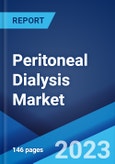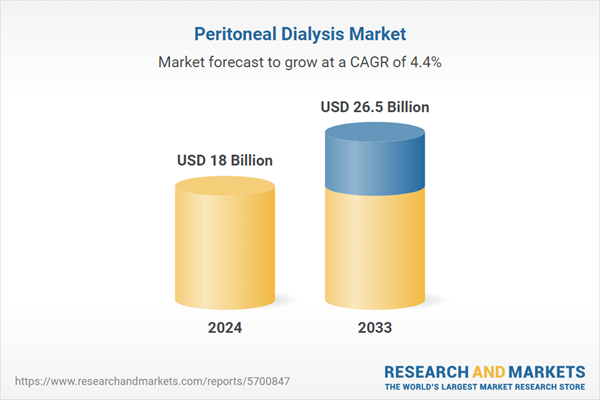Peritoneal dialysis (PD) represents a type of kidney failure treatment procedure wherein a soft plastic tube or catheter is placed in the abdominal lining or belly through surgery. Once it is positioned, a sterile cleansing fluid is transmitted by the duct that helps filter the blood inside an individual’s body by removing waste products. After a period of time, the liquid and filtered unwanted components flow out of the abdomen and are discarded.
PD is differentiated into continuous ambulatory peritoneal dialysis and continuous cycling peritoneal dialysis (CCPD). These approaches offer treatment flexibility, reduce the need to visit dialysis centers, and provide better clinical outcomes, resulting in lesser medications and fewer food restrictions. Apart from this, it can be carried out at home and is needle-free; thus, PD is used by hospitals and healthcare centers to treat kidney failures.
Peritoneal Dialysis Market Trends:
Growing prevalence of end-stage renal disease (ESRD)The growing prevalence of end-stage renal disease (ESRD) is a key factor driving the global peritoneal dialysis market growth as ESRD patients require dialysis or kidney transplantation to survive, with peritoneal dialysis emerging as a preferred treatment due to its convenience and home-based nature. According to the United States Renal Data System, there were 124,411 new ESRD diagnoses in 2015, with the disease increasing at about 20,000 cases per year. As the number of ESRD cases continues to rise globally, the demand for effective and accessible dialysis options, including peritoneal dialysis, increases. This trend is further supported by advancements in dialysis technologies, helping to meet the growing healthcare needs of the expanding ESRD population.
Increasing incidences of diabetes and hypertension
The rising incidences of diabetes and hypertension are significant drivers contributing to the augmenting peritoneal dialysis market share, as these conditions are the leading causes of chronic kidney disease (CKD) and end-stage renal disease (ESRD). Both diabetes and hypertension damage blood vessels and reduce kidney function over time, ultimately requiring dialysis or kidney transplantation for survival.With the global prevalence of diabetes and hypertension on the rise, particularly in aging population, there has been a corresponding increase in kidney failure cases. As a result, the demand for various dialysis treatments, including peritoneal dialysis, is escalating, thereby impelling the peritoneal dialysis market growth. This type of dialysis offers a convenient, home-based solution for patients, making it a preferred choice for managing kidney failure linked to these common health conditions.
Rising healthcare expenditures
Rising healthcare expenditures are also driving the market while enabling broader access to advanced dialysis treatments. As healthcare spending increases globally, especially in developed countries, more funds are allocated to managing chronic diseases like kidney failure. This allows for improved infrastructure, better-trained medical professionals, and access to cutting-edge peritoneal dialysis technologies.Additionally, according to the peritoneal dialysis market analysis report, increased healthcare budgets facilitate the adoption of home-based treatments, which can be more cost-effective and convenient compared to in-center hemodialysis. Government programs and insurance policies are also better positioned across numerous countries across the globe to support long-term dialysis care, thus easing the financial burden on patients and driving the demand for accessible, quality peritoneal dialysis solutions as part of comprehensive healthcare systems.
Peritoneal Dialysis Market Segmentation:
The research provides an analysis of the key trends in each segment of the market, along with forecasts at the global, regional, and country levels for 2025-2033. Our report has categorized the market based on treatment type, product, and end user.Breakup by Treatment Type:
- Continuous Ambulatory Peritoneal Dialysis (CAPD)
- Automated Peritoneal Dialysis (APD.
Breakup by Product:
- Peritoneal Dialysis Solution
- Peritoneal Dialysis Devices
- Peritoneal Dialysis Sets
- Peritoneal Dialysis Catheters
- Other.
Breakup by End User:
- Home-based Dialysis
- Dialysis Centers and Hospital-based Dialysi.
Breakup by Region:
- North America
- United States
- Canada
- Asia-Pacific
- China
- Japan
- India
- South Korea
- Australia
- Indonesia
- Others
- Europe
- Germany
- France
- United Kingdom
- Italy
- Spain
- Russia
- Others
- Latin America
- Brazil
- Mexico
- Others
- Middle East and Afric.
Competitive Landscape:
The report has also provided a comprehensive analysis of the competitive landscape in the global peritoneal dialysis market. Detailed profiles of all major companies have also been provided. Some of the companies covered include:- Amecath
- Baxter International Inc.
- Fresenius Medical Care AG & Co. KGaA
- Medical Components Inc.
- Medionics International Inc.
- Medtronic plc
- Merit Medical Systems Inc.
- Mitra Industries Pvt. Ltd.
- Newsol Technologies Inc.
- Nipro Canada (Nipro Medical Corporation)
- Poly Medicure Limited
- Terumo Corporation
- Utah Medical Products Inc.
Key Questions Answered in This Report:
- How has the global peritoneal dialysis market performed so far, and how will it perform in the coming years?
- What has been the impact of COVID-19 on the global peritoneal dialysis market?
- What are the key regional markets?
- What is the breakup of the market based on the treatment type?
- What is the breakup of the market based on the product?
- What is the breakup of the market based on the end user?
- What are the various stages in the value chain of the industry?
- What are the key driving factors and challenges in the industry?
- What is the structure of the global peritoneal dialysis market and who are the key players?
- What is the degree of competition in the industry?
Table of Contents
Companies Mentioned
- Amecath
- Baxter International Inc.
- Fresenius Medical Care AG & Co. KGaA
- Medical Components Inc.
- Medionics International Inc.
- Medtronic plc
- Merit Medical Systems Inc.
- Mitra Industries Pvt. Ltd.
- Newsol Technologies Inc.
- Nipro Canada (Nipro Medical Corporation)
- Poly Medicure Limited
- Terumo Corporation
- Utah Medical Products Inc
Table Information
| Report Attribute | Details |
|---|---|
| No. of Pages | 141 |
| Published | June 2025 |
| Forecast Period | 2024 - 2033 |
| Estimated Market Value ( USD | $ 18 Billion |
| Forecasted Market Value ( USD | $ 26.5 Billion |
| Compound Annual Growth Rate | 4.4% |
| Regions Covered | Global |
| No. of Companies Mentioned | 13 |









